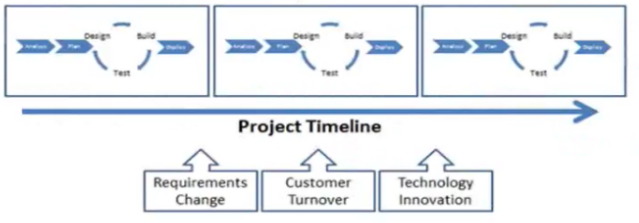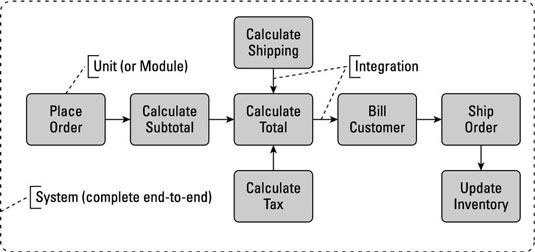Kanban !
Kanban is an Agile way of development just like Scrum being one. The main idea behind the Kanban system is to deliver what the process needs exactly when it needs it.The goal of Kanban is to identify potential bottlenecks in your process and fix them so work can flow through it cost-effectively at an optimal speed or throughput.The mantra is “Fail fast! Fail often!”
As stated on Wikipedia
Kanban(signboard or billboard in Japanese) is a scheduling system for lean manufacturing and just-in-time manufacturing (JIT). Taiichi Ohno, an industrial engineer at Toyota, developed kanban to improve manufacturing efficiency. Kanban is one method to achieve JIT.
While kanban was introduced by Taiichi Ohno in the manufacturing industry, it is David J. Anderson who was the first to apply the concept to IT, Software development and knowledge work in general in the year 2004.

The four foundational principles and six Core Practices of the Kanban Methodology are provided below:
- Start with what you are doing now: The Kanban Method (hereafter referred to as just Kanban) strongly emphasizes not making any change to your existing setup/ process right away. Kanban must be applied directly to current workflow. Any changes needed can occur gradually over a period of time at a pace the team is comfortable with.
- Agree to pursue incremental, evolutionary change: Kanban encourages you to make small incremental changes rather than making radical changes that might lead to resistance within the team and organization.
- Initially, respect current roles, responsibilities and job-titles: Unlike other methods, Kanban does not impose any organizational changes by itself. So, it is not necessary to make changes to your existing roles and functions which may be performing well. The team will collaboratively identify and implement any changes needed. These three principles help the organizations overcome the typical emotional resistance and the fear of change that usually accompany any change initiatives in an organization.
- Encourage acts of leadership at all levels: Kanban encourages continuous improvement at all the levels of the organization and it says that leadership acts don’t have to originate from senior managers only. People at all levels can provide ideas and show leadership to implement changes to continually improve the way they deliver their products and services.

6 Core Practices of the Kanban Method are as below:
- Visualize the flow of work:This is the fundamental first step to adopting and implementing the Kanban Method. You need to visualize – either on a physical board or an electronic Kanban Board, the process steps that you currently use to deliver your work or your services. Depending on the complexity of your process and your work-mix (the different types of work items that you work on and deliver), your Kanban board can be very simple to very elaborate. Once you visualize your process, then you can visualize the current work that you and your team are doing.
- Limit WIP (Work in Progress): Limiting work-in-progress (WIP) is fundamental to implementing Kanban – a ‘Pull-system’. By limiting WIP, you encourage your team to complete work at hand first before taking up new work. Thus, work currently in progress must be completed and marked done. This creates capacity in the system, so new work can be pulled in by the team.
- Manage Flow: Managing and improving flow is the crux of your Kanban system after you have implemented the first 2 practices. A Kanban system helps you manage flow by highlighting the various stages of the workflow and the status of work in each stage. Depending on how well the workflow is defined and WIP Limits are set, you will observe either a smooth flow within WIP limits or work piling up as something gets held up and starts to hold up capacity.
- Make Process Policies Explicit: As part of visualizing your process, it makes sense to also define and visualize explicitly, your policies (process rules or guidelines) for how you do the work you do. By formulating explicit process guidelines, you create a common basis for all participants to understand how to do any type of work in the system. The policies can be at the board level, at a swim lane level and for each column.
- Implement Feedback Loops: Feedback loops are an integral part of any good system. The Kanban Method encourages and helps you implement feedback loops of various kinds – review stages in your Kanban board workflow, metrics and reports and a range of visual cues that provide you continuous feedback on work progress – or the lack of it – in your system.
- Improve Collaboratively, Evolve Experimentally(using the scientific method): The Kanban Method is an evolutionary improvement process. It helps you adopt small changes and improve gradually at a pace and size that your team can handle easily. It encourages the use of the scientific method – you form a hypothesis, you test it and you make changes depending on the outcome of your test. As a team implementing Lean/ Agile principles, your key task is to evaluate your process constantly and improve continuously as needed and as possible.
How does it work ?
Kanban board model, there are three columns, as shown in the picture below:
- “To Do”: This column lists the tasks that are not yet started. (aka “backlog”)
- “Doing”: Consists of the tasks that are in progress.
- “Done”: Consists of the tasks that are completed.
 Kanban boards can show elaborate workflows depending on the complexity of the workflow and the need to visualize and examine specific parts of the workflow to identify bottlenecks in order to remove them.
Kanban boards can show elaborate workflows depending on the complexity of the workflow and the need to visualize and examine specific parts of the workflow to identify bottlenecks in order to remove them.Kanban WIP Limits:
A key aspect of Kanban is to reduce the amount of multi-tasking that most teams and knowledge workers are prone to do and instead encourage them to “Stop Starting! And Start Finishing!”, a mantra coined by Dr. Arne Roock (of www.Software-Kanban.de). WIP – Work-in-Progress – Limits defined at each stage of the workflow on a Kanban board encourage team members to finish work at hand and only then, take up the next piece of work.
Ref:
digite-kanban
wikipedia-kanban



I am certain that the useful you shared through your post is helpful for individuals. I am inspired with the method for composing. It kept associated me constantly. Keep doing awesome.
ReplyDeleteGoal Tracker App iphone
Kanban is a lean project management system that optimizes workflow. Visualizing tasks on boards, it promotes efficiency and collaboration. 3 Ark Best From manufacturing to software development, Kanban revolutionizes.
ReplyDelete